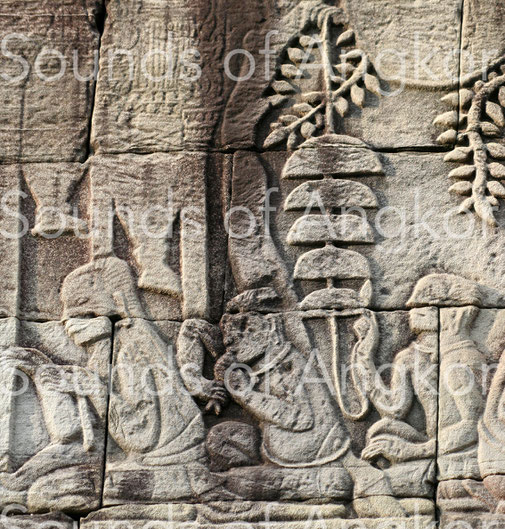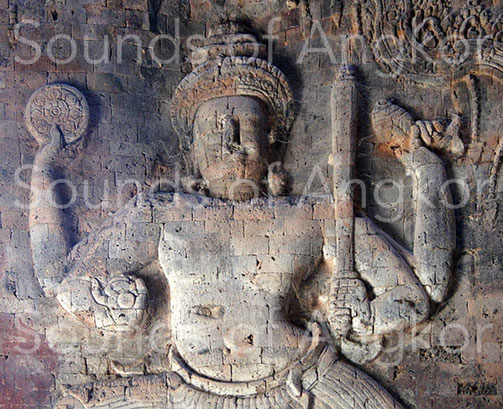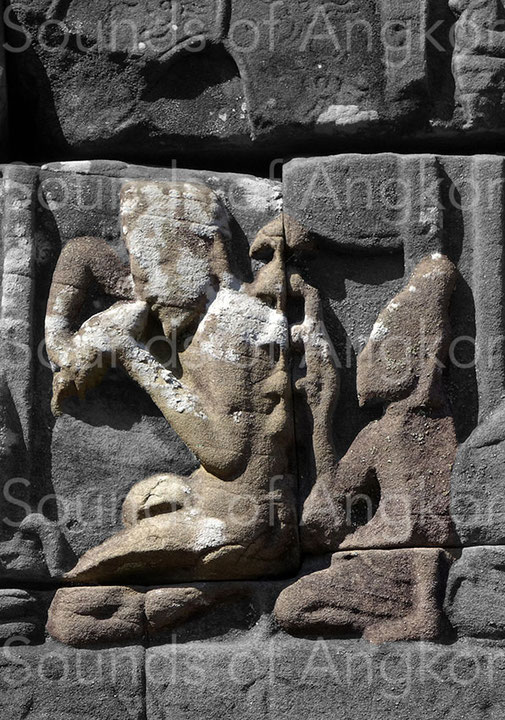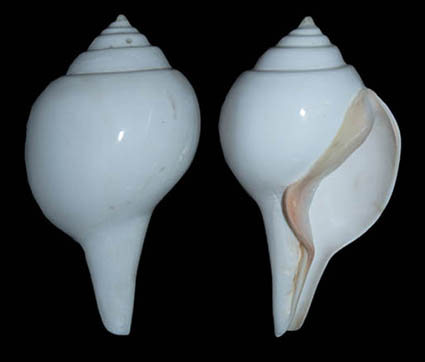A shell of the class of gastropods or its facsimile in which one blows is called conch. It is one of the attributes of the god Viṣṇu (photos 1ab, 3ab).
On the bas-reliefs of the Bayon and Angkor Wat, the conches are mostly presented in battle scenes, commemorative or fictitious, in the scenes of the Reamker and Mahābhārata, as well as in Brahmanic rituals. The sculpture does not allow us to define the material.
In contemporary India and Nepal, the gastropod Turbinella pyrum is preferentially used, from which the apex is severed; it is used either as a sound tool or as a waving container. Other species of gastropods are also used.
Concerning the blowing conch, two types of instruments seem to have coexisted, a marine gastropod decorated or not with a metal frame made of copper, silver or gold alloy, and a substitute for the shell made of terra cotta.
On the martial bas-reliefs, the conches are played solo or in duet. They remain used in the personal or collective rituals of the Hindus and by the Tibetan Buddhists. The latter use the gastropod Turbinella pyrum and are designated by the Tibetan term dung-dkar (photo 2), literally "white shell". The latter is often engraved and decorated with a metallic wing inlaid with gemstones.
Conch trough iconography
Martial use
In Angkorian iconography, the position of the figures blowing in the conches varies: from the front blowing down (4), from the profile blowing down or up (6), from the back with the head tilted backwards blowing up (5,7). In Angkor Wat, when two conch players operate side by side, one blows downwards and the other blows upwards, except in the scenes of the Historic Parade or the Reamker monkeys. The entire sound space is thus occupied. Recall that among the Khmer people, there are ten directions: the four cardinal points, the four inter-cardinal ones, the top and the bottom. As for the cheeks of the musicians, they show a real prominence under the action of the air accumulated in the oral cavity.
Ritual use
Conchs are also use in temples. Two bas-reliefs from Bayon show an officiant blowing into a conch while another strikes a tree with five bells.

Today conch shells are still used at the Royal Court of Cambodia in Phnom Penh by Hindu priests (baku) during important ceremonies. They blow in a pair of Charonia tritonis gastropods called kchong seang in Khmer. Their first windings are covered of silver. Eight of these were seen during the funeral procession of King Norodom Sihanouk in 2012.
Conch trough epigraphy
The Old Khmer term designating the conch is similar to the Sanskrit śaṅkha. But this term can refer to four different elements: the conch to be blown, the one to lustral water offering, one of the attributes of Viṣṇu and mother-of-pearl. Śaṅkha is one of the rare words to have passed through times without modification. The inscriptions corroborate iconography: the conch is present both in the temple and on the battlefield. It is frequently cited as material property offered to temples. However, the texts don't specify whether it is conch to blow or to offer lustral water.
Conchs (without precision of their nature) were once objects of great value because of their rarity. There are two variants: one, dexter, most common, the other, sinister, which is extremely rare for a species normally dexter, around one in a million to give ours readers an order of idea. It can then be understood that this type of conch could have reached very hight prices. There is however a gastropod, Busycon contrarium, whose specificity is to be always sinister. The old inscriptions, however, make no mention of this important detail.
In the stele of Prasat Komphus, there is a list of musical instruments, some of which are accompanied by aesthetic characteristics. It is specified in connection with the donation of the seven conchs: "śaṅkha nu kānti" or, according to the translation of G. Coedes: "conchs with kānti". The term kānti remains indeterminate. It could be, as a hypothesis, a metallic frame, as can be seen on certain war shells of the bas-reliefs of Angkor Wat (certainly later than this inscription) or as they are on the Tibetan conchs.
The Old Khmer term designating the conch is similar to the Sanskrit śaṅkha. But this term can refer to four different elements: the conch to be blown, the one to undulating, the conch attribute of Viṣṇu and mother-of-pearl. Śaṅkha is one of the rare words to have passed through times without modification. The inscriptions corroborate iconography: the conch is present both in the temple and on the battlefield. It is frequently cited as material property offered to temples. However, the texts don't specify whether it is conch to blow or to offer lustral water.
Conchs (without precision of their nature) were once objects of great value because of their rarity. There are two variants: one, dexter, most common, the other, sinister, extremely rare for a species normally dexter, around one in a million to give an order of idea. It can then be understood that this type of conch could have reached very hight prices. There is however a gastropod, Busycon contrarium, whose characteristic is to be always sinister. The lapidary inscriptions, however, make no mention of this important detail.
In another inscription - stele of Prasat Komphus - there is a list of musical instruments, some of which are accompanied by aesthetic characteristics. It is specified in connection with the donation of the seven conchs: "śaṅkha nu kānti" or, according to the translation of G. Coedes: "conchs with kānti". The term kānti remains indeterminate. It could be, as a hypothesis, a metallic frame, as can be seen on certain war shells of the bas-reliefs of Angkor Wat (certainly later than this inscription) or as they are on the Tibetan conchs.
Contemporary ritual use
Today, conch shells are still used at the Royal Court of Cambodia in Phnom Penh by Hindu officiants (purohit បុរោហិត, barku puruhit បារគូបុរោហិត or simply barku បារគូ) during important ceremonies. They blow into shells of Charonia tritonis, called khyang sang ខ្ចង់ស័ង្ខ, whose first coils are covered in silver. They are blown during important ceremonies (Sacred Furrow Festival, royal funerals...). We are currently unaware of when these very particular conches were introduced at the court of Cambodia. At the court of Thailand, priests continue to blow into Turbinella pyrum shells.
The conch shell through Buddhist painting
Episode of the Reamker. Cambodia, early 1900s, tempera on canvas, acquired 1920. s6322
The Reamker រាមកេរ្តិ៍ is the Khmer version of the Rāmāyaṇa. This painting describes what happened after an arrow from Preah Ream's bow killed the demon king Krong Reap and Neang Seda was freed. The scene reads from bottom to top. In the lower part, Neang Seda, who has been held on the island of Lanka for twelve years, is invited by her husband Preah Ream to prove her fidelity by crossing the fire (Ordalia). When she enters the fire, a lotus flower springs up to protect her from the flames. Her fidelity established, the couple are reunited. The central section depicts the coronation of Preah Ream's ally, the soothsayer Pipaet, as King of Lanka after the death of his brother Krong Reap. During the ceremony, Pipaet takes Neang Montolkiri and Neang Akinaet as his queens. The upper section illustrates the elaborate pavilion and funerary urn that Pipaet prepared for Krong Reap's cremation. Two baku blow into conches.
Episode of the Reamker. Cambodia, early 1900s, tempera on canvas, acquired 1920. w6325.
This work illustrates the events that took place after the twins Reamleak and Jupleak went to live with their father, Prince Preah Ream, in the town of Ayuddhya. It reads from bottom to top. At the bottom, Preah Ream holds a ceremonial procession to mark the arrival of his sons. He then blesses the boys with lustral water and asks them to invite their mother, his wife Neang Seda, to join them in Ayuddhya. The center shows the journey made by ReamLeak, Jupleak and members of the royal court to visit Neang Sita in the countryside. The upper part shows the boys, accompanied by a group of court ladies, imploring their mother to return with them. After she refuses, Reamkeak, Jupleak and their entourage leave. Two baku blow into conches.




































